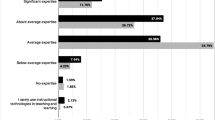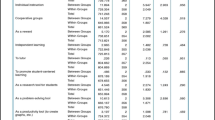Abstract
Many school districts across the United States have enacted one-to-one (1:1) programs to boost students’ “21st Century Skills”. These programs provide a laptop or other personal digital device to every student, with the expectation that teachers will employ modern instructional processes and students will benefit from greater access to knowledge, tools, and both collaborative and individualized instruction. The transformative potential of 1:1, along with the varied contextual variables, makes program implementation difficult. This paper discusses the partial results of a year-long 1:1 laptop program evaluation in one Pennsylvania district. The study employs multiple methods to obtain an initial view of the programs’ impact on students. The study found that, overall, students did not have positive perceptions of the 1:1 program or its impacts, and a significant decline was found for many indicators between semesters. Regression analysis of the collected data suggests that greater use of the 1:1 laptops, along with a robust IT infrastructure, significantly predicts the perceived level of impact a 1:1 program has on students. The information obtained from this case study provides further insight into how attitudes, behavior, and perceptions of students are impacted by these programs.



Similar content being viewed by others
Explore related subjects
Discover the latest articles, news and stories from top researchers in related subjects.Notes
The name of the school district has been changed for anonymity.
References
Argueta, R., Huff, J., Tingen, J. & Corn, J.O. (2011). Laptop initiatives: summary of research across six states. friday institute for educational innovation, North Carolina State University.
Barron, A. E., Kemker, K., Harmes, C., & Kalaydjian, K. (2003). Large-scale research study on technology in K-12 schools: technology integration as IT relates to the national technology standards. Journal of Research on Technology in Education, 35(4), 489–507.
Bebell, D. (2005). Technology promoting student excellence: an investigation of the first year of 1:1 computing in New Hampshire middle schools. Chestnut Hill, MA: inTASC, Boston College.
Bebell, D., & Kay, R. (2010). One-to-one computing: a summary of the quantitative results from the Berkshire wireless learning initiative. Journal of Technology, Learning, and Assessment, 9(2).
Cho, V., & Littenberg-Tobias, J. (2016). Digital devices and teaching the whole student: developing and validating an instrument to measure educators’ attitudes and beliefs. Educational Technology Research and Development, 64(4), 643–659.
Churchill, D. (2006). Teachers' private theories and their design of technology-based learning. British Journal of Educational Technology, 37(4), 559–576.
Corn, J. (2010). Examining issues critical to a 1:1 learning environment: principal leadership. Friday Institute for Educational Innovation: North Carolina State University.
Fairman, J. (2004). Trading roles: teachers and students learn with technology. Maine Education Policy Research Institute, The University of Maine Office.
Fletcher, G. H. (2004). Technology breeds collaboration. T H E Journal, 32(5), 2–3.
Hilberg, J. & Meiselwitz, G. (2008). Undergraduate fluency with information and communications technology: perceptions and reality. Proceedings of the SIGITE 2008 Conference on Information Technology Education, Cincinnati, OH.
Hill, J., & Reeves, T. (2004). Change takes time: the promise of ubiquitous computing in schools. A report of a four year evaluation of the laptop initiative at Athens academy. Athens, GA: University of Georgia.
Islam, M. S., & Grönlund, Å. (2016). An international literature review of 1:1 computing in schools. Journal of Educational Change, 17(2), 191–222.
Johnson, J. (2008). Can a laptop change how the world teaches? Knowledge Quest, 36(4), 72–73.
Keengwe, J. (2012). Laptop initiative: impact on instructional technology integration and student learning. Education and Information Technologies, 17(2), 137.
Larkin, K. (2012). You use! I use! We use! Questioning the orthodoxy of one-to-one computing in primary schools. Journal of Research on Technology in Education, 44(2), 101–120.
Lei, J., & Zhao, Y. (2008). One-to-one computing: what does it bring to schools? Journal of Educational Computing Research, 39(2), 97–122.
Lowther, D. L., Ross, S. M., & Morrison, G. M. (2003). When each one has one: the influences on teaching strategies and student achievement of using laptops in the classroom. Educational Technology Research and Development, 51(3), 23–44.
Lowther, D., Strahl, D., Inan, F., & Bates, J. (2007). Freedom to learn program Michigan 2005–2006 evaluation report. Memphis, TN: Center for Research in Education Policy Retrieved from http://www.memphis.edu/crep/pdfs/ Michighan_Freedom_to_Learn_Laptop_Program.pdf.
Maninger, R., & Holden, M. E. (2009). Put the textbooks away: preparation and support for a middle school one-to-one laptop initiative. American Secondary Education, 38(1), 5–33.
McDermott, K. (2006). Incentives, capacity, and implementation:evidence from Massachusetts education reform. Journal of Public Administration Research and Theory, 16(1), 45–65.
McGhee, R. & Kozma, R. (2003). New teacher roles in the technology-supported classroom. SRI International. Retrieved February 01, 2009 from http://www.edtechcases.info/papers/teacherstudentroles.pdf.
Molina, A., Sussex, W., & Penuel, W. R. (2005). Training wheels evaluation report. Menlo Park, CA: SRI International.
Moore, D. (2009). Ready for 1:1. Tech & Learning, 30(1), 34–35.
Mouza, C. (2008). Learning with laptops: implementation and outcomes in an urban, under-privileged school. Journal of Research on Technology in Education, 40(4), 447–472.
Muir, M., Manchester, B., & Moulton, J. (2005). Special topic: learning with laptops. Educational Leadership, 62(Summer).
Murray, M., Hooper, J. & Perez, J. (2007). A project-based approach to assessing student competency with productivity software. Proceedings of the AIS SIG-ED International Academy for Information Management 2007 Conference, Montreal, Quebec.
O’Hanlon, N. (2002). Net knowledge: performance of new college students on an internet skills proficiency test. The Internet and Higher Education, 5(1), 55–66.
Partnership for 21st Century Skills (2008). 21st century skills, education and competitiveness: a resource and policy guide. Tucson, AZ: The Partnership for 21st Century Skills.
Penuel, W. (2006). Implementation and effects of one-to-one computing initiatives: a research synthesis. Journal of Research on Technology in Education, 38(3), 329–348.
Rosen, Y., & Beck-Hill, D. (2012). Intertwining digital content and a one-to-one laptop environment in teaching and learning: lessons from the time to know program. Journal of Research on Technology in Education, 44(3), 225–241.
Shapley, K., Sheehan, D., Maloney, C., & Caranikas-Walker, F. (2008). Evaluation of the Texas technology immersion pilot: Outcomes for the third year (2006–07). Retrieved from http://www.etxtip.info/TechnologyImmersionProject.
Shapley, K. S., Sheehan, D., Maloney, C., & Caranikas-Walker, F. (2010). Evaluating the implementation fidelity of technology immersion and its relationship with student achievement. The Journal of Technology, Learning, and Assessment, 9(4).
Spanos, D., & Sofos, A. (2015). The views and attitudes of students participating in a one-to-one laptop initiative in Greece. Education and Information Technologies, 20(3), 519–535.
Stone, J. (2015). Teacher perceptions in the life of a defunct 1:1 Program. Proceedings of the Society for Information Technology and Teacher Education International Conference, Las Vegas, NV.
Stone, J., & Madigan, E. (2007). Inconsistencies and disconnects: a disturbing report on the information and communication technology skills of incoming freshmen. Communications of the ACM, 50(4), 76–79.
Tatar, D., Roschelle, J., Vahey, P., & Penuel, W. R. (2003). Handhelds go to school. IEEE Computer, 36(9), 30–37.
Vaast, E., & Walsham, G. (2005). Representations and actions: the transformation of work practices with IT use. Information and Organization, 15(1), 65–89.
Wallis, C. & Steptoe, S. (2006). How to bring our schools out of the twentieth century. TIME, Retrieved from http://www.time.com/time/magazine/article/0,9171,1568480,00.html.
Warschauer, M. (2006). Going one-to-one. Learning in the Digital Age, 63(4), 34–38.
Warschauer, M. (2014). Balancing the one-to-one equation: equity and access in three laptop programs. Equity & Excellence in Education, 47(1), 46–62.
Warschauer, M., Arada, K., & Zheng, B. (2010). Laptops and inspired writing. Journal of Adolescent & Adult Literacy, 54(3), 221–223.
Weston, M., & Bain, A. (2010). The end of techno-critique: the naked truth about 1:1 laptop initiatives and educational change. The Journal of Technology, Learning, and Assessment, 9(6).
Zucker, A., & Light, D. (2009). Laptop programs for students. Science, 323(5910), 82–85.
Author information
Authors and Affiliations
Corresponding author
Rights and permissions
About this article
Cite this article
Stone, J.A. The impact of technology exposure on student perceptions of a 1:1 program. Educ Inf Technol 22, 2281–2309 (2017). https://doi.org/10.1007/s10639-016-9541-6
Published:
Issue Date:
DOI: https://doi.org/10.1007/s10639-016-9541-6




